How to Take Your Kids Fishing and Make It Memorable
There’s nothing quite like taking your kids fishing and seeing the joy on their faces when they catch their first fish. It’s a memory that will stay with them forever. It also allows you to bond over a common interest while teaching them patience, responsibility, and respect for nature.
But sometimes, taking your kids fishing can be less than enjoyable if they’re not adequately prepared or don’t understand the basics of the sport. To spend a fun day out on the water with your kids, follow these tips to take your kids fishing and make it memorable.
1. Get Kid-Appropriate Fishing Gear
If you’re going to take your kids fishing, you must ensure they have the proper gear.
That doesn’t mean going out and buying the most expensive rod and reel on the market, but it does mean getting gear that is the appropriate size for them and will withstand a good amount of wear and tear.
Here are some kid-appropriate fishing gears.
Rods

This will make the difference between a fun day fishing and a frustrating one. If the rod is too long, your child will have a hard time casting and will get tired quickly. If it’s too short, they won’t be able to reach the fish.
Look for a rod around 3-4 feet in length, specifically for kids. Kids can easily break stuff, so you need to get a rod that are made of composite beads, fiberglass, or graphite. These materials can withstand a fair bit of abuse and are also very lightweight.
A telescoping rod is also a good option as you can adjust it to different lengths as your child grows. You also don’t need to worry about the weight of kids’ rods. A lighter rod will be easier to handle and won’t tire them out quickly.
Reels
There are two different types of reels- spinning and baitcasting. Spinning reels are the most popular type among novice anglers, including kids, as they are the easiest to use. On the other hand, baitcasting reels require more skill and are better suited for experienced anglers.
When choosing a reel, you must also consider the type of fish you will target. As for your kid, they can only catch a small fish, so a smaller reel should be fine. Remember, they will need a reel that is easy to operate and can be adjusted to their smaller hands.
You can opt for a push-button fishing reel or spin cast. They are the easiest to use for kids and will help them enjoy their day fishing.
Net

You will need a net when you’re taking your kids fishing. They will likely catch smaller fish and won’t be able to hold on to them with their hands. Look for a high-quality net with soft mesh because it doesn’t damage the fish’s scales.
As for the handle, opt for a shorter one because it is easier for kids to handle and maneuver. Alternatively, you can get a net with a telescopic or collapsible handle so you can either shorten or length it when needed.
Live Bait and Lure
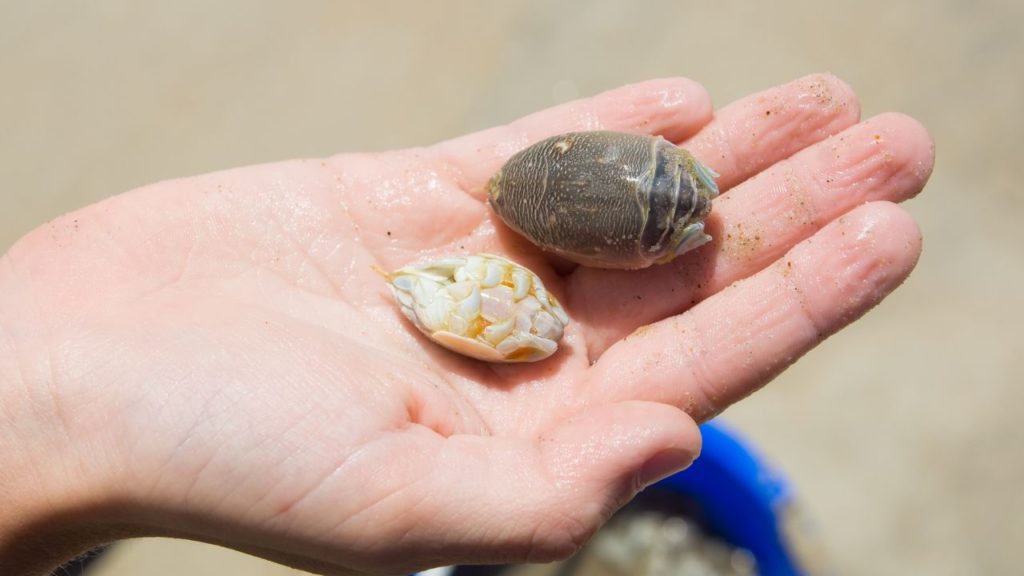
Kids can have a lot of fun catching their own bait. You can do this with a simple fishing net or a bucket. Baitfish like sandfleas will often congregate in areas where there is moving water. Keep in mind that you’ll need to put them in a live well or bait bucket with aerated water so they don’t die.
For lures, it’s best to start with simple ones that are easy to use. Spinners and crankbaits are good choices as they don’t require a lot of skill to use.
You can also get creative and make your lures out of objects around the house, like bottle caps or pieces of metal. And if your kid loves being creative, plenty of DIY kits are available that allow them to make their lures.
Pliers
Removing hooks from fish can be tricky, especially for kids. That’s why it’s important to have a good pair of pliers on hand. Look for a pair that is comfortable to hold and has a good grip.
It will give your child an easier time removing the hook from the fish and will prevent them from getting pricked by the hook. As a bonus, pliers can also help remove tangled lures from trees or other objects.
Hooks
You may need to use smaller hooks that are easier to handle with kids. You need to avoid using hooks with barbs as they can be difficult to remove and are more likely to injure the fish.
If you’re using live bait, you’ll want to use bait holder hooks. These hooks have a small wire that holds the bait in place and prevents it from slipping off. You should carry small hooks for small fish, which is the appropriate size for kids.
Tackle Box

Once you have all the necessary gear, you’ll need to store it somewhere. A tackle box is a perfect solution as it keeps everything organized and in one place.
When choosing a tackle box, look for one that is lightweight and easy for your child to carry. Also, ensure that it has plenty of compartments and trays to store all of your child’s gear.
Fish Identification Guide
You should get a fish identification guide for an easier and more fun fishing trip with your kids.
Most guides come with pictures and descriptions of the different types of fish. This is a great way to teach your kids about the different fish species and help them understand the fish they are catching.
Other Things You Should Bring:
- Fishing snacks
- Life Jackets
- First Aid Kit
- Sunscreen
- Sunglasses
- Hats
- Chair
2. Teach Fishing Laws and Regulations
Before heading out on your fishing trip, it’s essential to teach your kids about the laws and regulations regarding fishing. This will help them be responsible anglers and ensure they follow the rules.
In most states, kids under 16 do not need a fishing license. However, different states have different age limits for a license. For example, kids aged 15 years and below do not require a fishing license in California.
In Arizona, the legal age is ten years and below. You need a fishing license in Arkansas if you are 16 years and above. For a guardian or parent that is going to be assisting their kid, you should have a license as well.
You should check the fishing regulations in your state before heading out on your trip. Also, teach them the size and creel limits for the fish you hope to catch.
The catch and release method is also good for fishing with kids. This ensures that the fish population remains healthy and allows other anglers to enjoy the sport.
3. Find A Location
Getting a good fishing location is key to a successful fishing trip with kids. You’ll want to find a spot that is safe for kids, easily accessible, and has plenty of fish.
If you’re new to the area, you can ask the local bait shop for suggestions. But a small pond near a shoreline is an excellent place to start. As your kids get more comfortable and experienced, you can venture out to larger lakes and streams.
4. Rig A Basic Setup
The simplest and safest rig for kids is the hook, sinker/split shots, and bobber setup. To set up, you need to tie a fishing line to the end of your rod. Then, attach a small sinker or split shot about 18 inches from the end of the line.
After the sinker, add a small hook size of 10 or 12; bait your hook with live bait or a small piece of plastic worm. To finish, tie a bobber onto the line about 2 feet above the hook. The bobber will keep your bait suspended in the water and act as a bite indicator. You should also not overcomplicate it. It will only frustrate your kids if they can’t figure it out.
5. Practice Casting
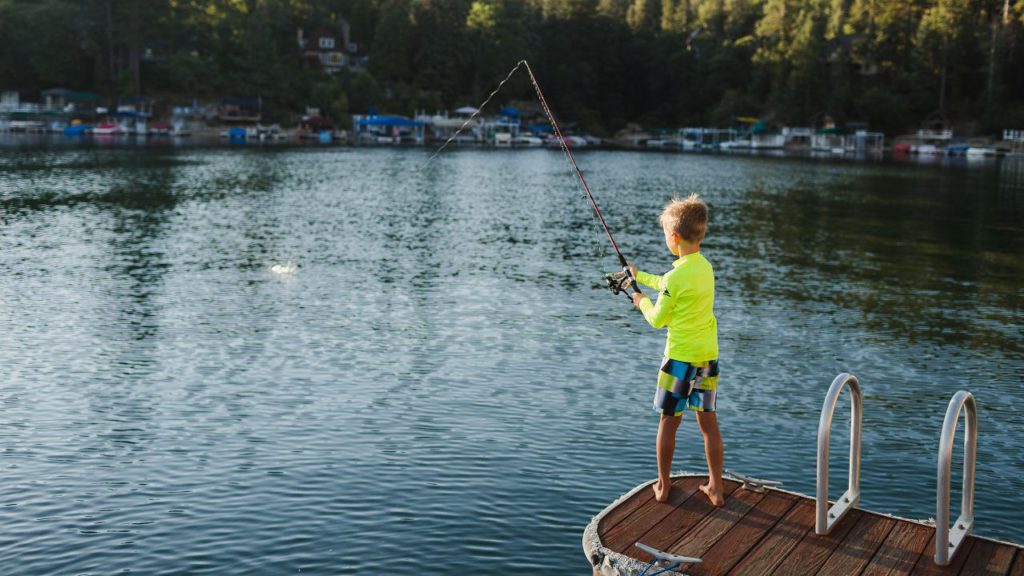
You need to spend some time practicing casting before heading out on your trip. This will help your kids to become more accurate and avoid tangles.
To practice, have your kids stand in an open area and hold the rod with their dominant hand. Then, have them use their other hand to pull the line back until it’s tight. With a smooth motion, have them release the line and allow it to fly forward.
They can add more power to their casts as they become more comfortable with the motion. Just ensure they keep their wrist firm to avoid getting the line tangled.
Here are some tips for practicing casting:
- Use an Open Field with Few Obstructions: This will help avoid getting your line tangled in trees or bushes. Your kids should also be standing at least 10 feet apart to avoid crossing lines.
- Start with Short Casts: Have your kids start by casting for short distances. They can gradually increase their distance as they become more comfortable with their casting.
- Use a Lighter Rod: You’ll want to use a lighter rod for kids so they can easily handle it. You can also use smaller lures to make casting easier.
6. Target Small Fish
You’ll want to target smaller fish when fishing with kids. They’re easier to catch and won’t put up too much of a fight. This will help keep your kids interested in fishing and avoid frustration.
Some good fish to target include minnows, panfish, and Crappie. And when your kids’ skills advance, they can move on to larger fish like bass, catfish, and trout.
Crappie
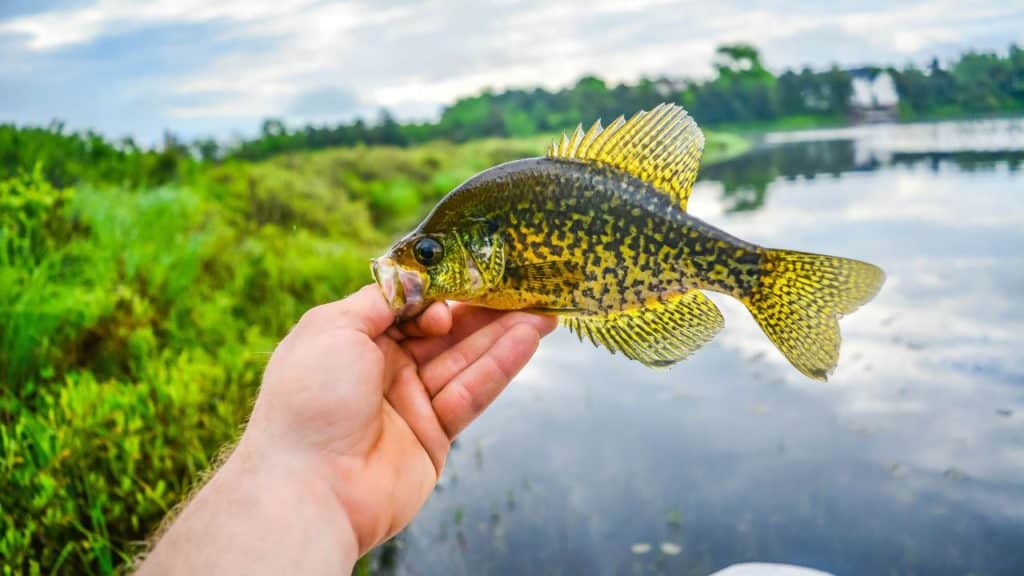
Crappie is a type of freshwater fish that is related to sunfish. They’re found in ponds, lakes, and rivers across the United States.
They’re popular for kids because they’re relatively easy to catch. Since crappies can put up a good fight when they’re hooked, your kids can feel a sense of accomplishment when they reel one in.
When fishing for crappies, look for them around docks, submerged trees, and other structures in the water. They’re often found in schools, so you may need to cast your line out several times before you hook one.
Minnows
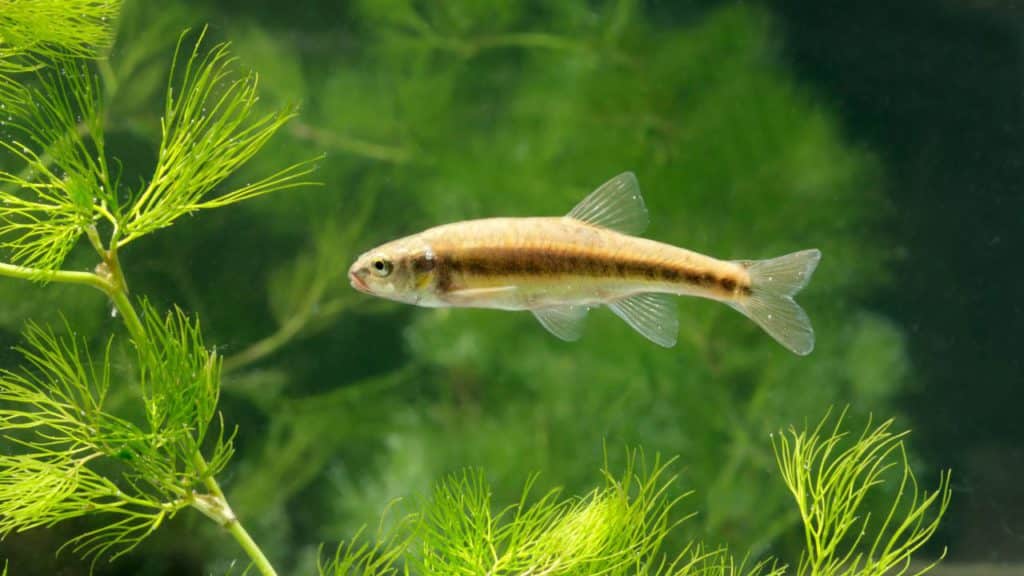
Minnows are small fish that you’ll find in freshwater habitats across the world. Reeling in a minnow is often one of the first fishing experiences for many kids. This is because this type of fish is relatively easy to catch and doesn’t put up much of a fight.
You can find minnows in various habitats, but they’re often found in areas with a lot of vegetation. You can use live bait or lures when fishing for minnows.
Panfish
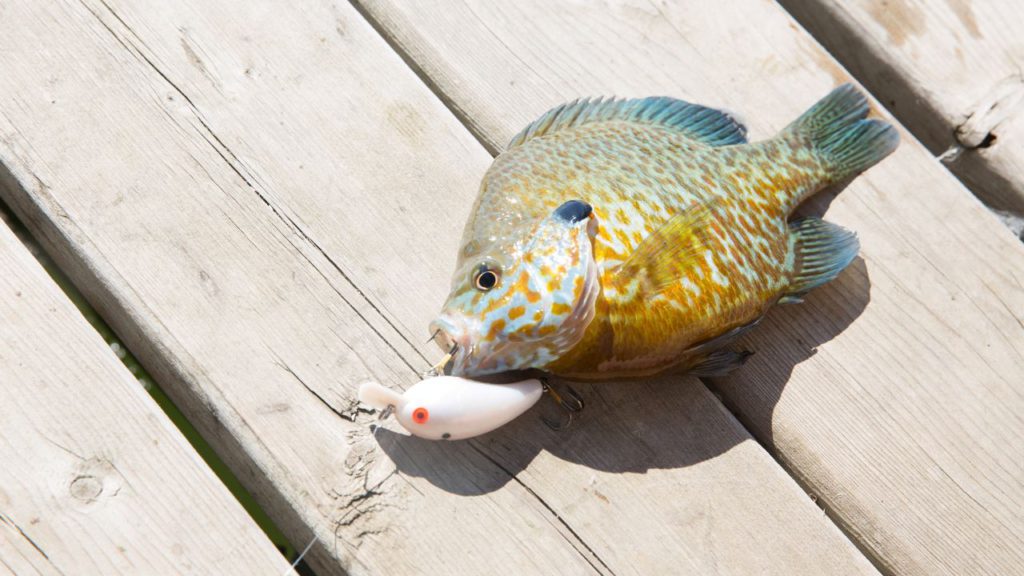
This is a term used to describe a variety of small freshwater fish. The most common type of panfish is the bluegill and perch. You can find these fish in most ponds and lakes. They are fun to catch and make great eating.
Some baits that work well are small minnows, crayfish, and insects. The best place to start when fishing for panfish is along the shoreline. Look for areas with vegetation or structure that the fish can use for cover.
7. Teach Patience
Fishing allows you to teach kids about patience. This will help them develop good skills they can use in other areas of their life. It will also help them understand that fishing involves tangles, snags, and backlashes. Most importantly that fishing requires time, effort, and patience to be successful.
8. Have a Backup Plan
Creating a backup plan is always a good idea when fishing with kids. They can get bored easily, so you must have some activities you can do if the fishing is slow.
Some suitable backup activities include playing games, exploring nature, and teaching them about different types of fish. They can also go to a nearby park to run off any extra energy after the trip.
Make Your Kid’s First Fishing Trip Memorable
Taking your kids fishing for the first time can be a bit daunting. You want them to have a good time, but you also don’t want to end up with a bunch of bait in your face and a line wrapped around your leg.
To make their first fishing trip memorable, start by teaching them the basics. Then, find a good spot to fish and target small fish. Remember to have a backup plan in case the fishing is slow.
With some preparation, you can ensure that your kids have a fun and memorable first fishing trip.
Table of Contents



